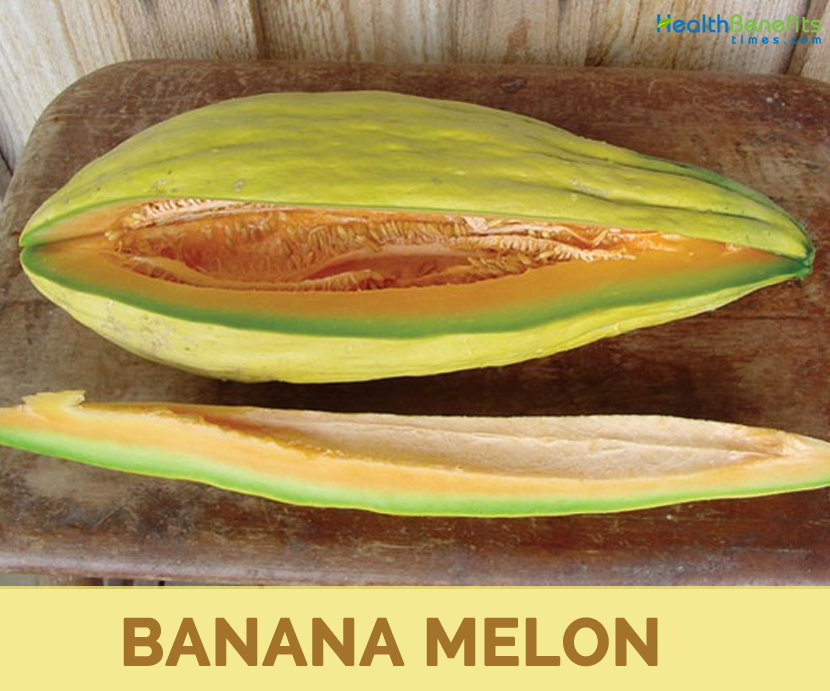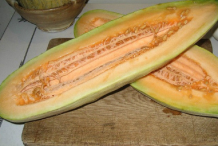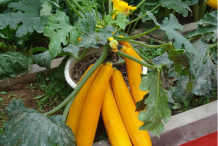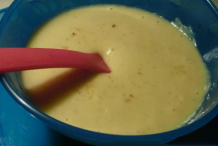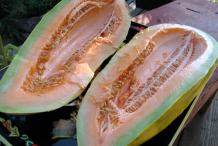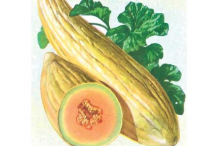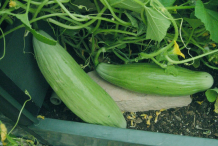| Banana Melon Quick Facts |
| Name: |
Banana Melon |
| Colors |
Green when young turning to yellow as they ripe |
| Shapes |
Banana shaped melons up to 16 to 24 inches long and 4 inch in diameter |
| Taste |
Salmon-colored flesh |
| Calories |
21 Kcal./cup |
| Major nutrients |
Vitamin C (9.00%)
Vitamin B9 (5.00%)
Vitamin K (4.08%)
Copper (3.89%)
Vitamin B6 (3.85%)
|
Banana melon which looks like a cross between a papaya and a banana is actually a sister of cantaloupe and cousin of cucumber. It not only looks like a banana but also has a hint of banana taste together with cantaloupe, as well as a hint of banana aroma. It has a salmon-colored flesh, much like cantaloupe and a yellow rind. Banana melon plant prefers full sunlight location with well-drained soil for good production. Some say it gets its name from the shape and some say it has a banana like flavor. This melon is wonderful as a dessert or snack. It is also use to perk up salads, salsas, entrees and drinks.
Plant Description
Banana melon plant is a vining warm season plant that grows in full sunlight location and prefers well-drained, fertile soil amended with compost or well-rotted manure. A 2-inch layer of compost or dry manure should be worked into the soil over the planting area to about a depth of 6 inches. The plant yields tasty elongated banana shaped melons up to 16 to 24 inches long and 4 inch in diameter and average weight up to 5 to 8 pounds each. Fruit is normally green when young turning to yellow as they ripe. Banana melon has smooth yellow skin and salmon-colored flesh. Banana melons rapidly turn yellow in a short time as it ripens. You can also check the stem of each fruit for dryness. Ripe fruits have a dry stem that is brown and somewhat shriveled. Ripe fruit has mild, distinctive, evocative flavor and luscious, papaya-like texture.
Nutritional Values of Banana Melon
Apart from their mild, distinctive, evocative flavor and luscious, papaya-like texture, Banana melon is a good source of nutrients, vitamins and minerals. Consuming 100 gram of Banana melon offers 8.1 mg of Vitamin C (Ascorbic acid), 20 µg of Vitamin B9 (Folate), 4.9 µg of Vitamin K (phylloquinone), 0.035 mg of Copper, 0.05 mg of Vitamin B6 (Pyridoxine), 4.06 g of Carbohydrate, 140 mg of Potassium, 0.46 mg of Vitamin B3 (Niacin) and 0.21 mg of Iron.
Nutritional value of Banana Melon (Navajo)
Serving Size: 100 g
Calories 21 K cal. Calories from Fat 1.8 K cal.
| Proximity |
Amount |
% DV |
| Water |
94.66 g |
N/D |
| Energy |
21 Kcal |
N/D |
| Energy |
90 kJ |
N/D |
| Protein |
0.84 g |
1.68% |
| Total Fat (lipid) |
0.2 g |
0.57% |
| Ash |
0.24 g |
N/D |
| Carbohydrate |
4.06 g |
3.12% |
| Total dietary Fiber |
0.3 g |
0.79% |
| Total Sugars |
3.36 g |
N/D |
| Glucose (dextrose) |
1.3 g |
N/D |
| Fructose |
2.06 g |
N/D |
| Minerals |
Amount |
% DV |
| Calcium, Ca |
13 mg |
1.30% |
| Iron, Fe |
0.21 mg |
2.63% |
| Magnesium, Mg |
10 mg |
2.38% |
| Phosphorus, P |
9 mg |
1.29% |
| Potassium, K |
140 mg |
2.98% |
| Sodium, Na |
11 mg |
0.73% |
| Zinc, Zn |
0.14 mg |
1.27% |
| Copper, Cu |
0.035 mg |
3.89% |
| Manganese, Mn |
0.036 mg |
1.57% |
| Selenium, Se |
0.4 µg |
0.73% |
| Vitamins |
Amount |
% DV |
| Water soluble Vitamins |
| Vitamin B1 (Thiamin) |
0.02 mg |
1.67% |
| Vitamin B2 (Riboflavin) |
0.018 mg |
1.38% |
| Vitamin B3 (Niacin) |
0.46 mg |
2.88% |
| Vitamin B5 (Pantothenic acid) |
0.07 mg |
1.40% |
| Vitamin B6 (Pyridoxine) |
0.05 mg |
3.85% |
| Vitamin B9 (Folate) |
20 µg |
5.00% |
| Folate, food |
20 µg |
N/D |
| Vitamin C (Ascorbic acid) |
8.1 mg |
9.00% |
| Fat soluble Vitamins |
| Vitamin K (phylloquinone) |
4.9 µg |
4.08% |
*Above mentioned Percent Daily Values (%DVs) are based on 2,000 calorie diet intake. Daily values (DVs) may be different depending upon your daily calorie needs. Mentioned values are recommended by a U.S. Department of Agriculture. They are not healthbenefitstimes.com recommendations. Calculations are based on average age of 19 to 50 years and weighs 194 lbs.
Culinary Uses
- This melon is wonderful as a dessert or snack.
- It is also use to perk up salads, salsas, entrees and drinks.
Comments
comments



